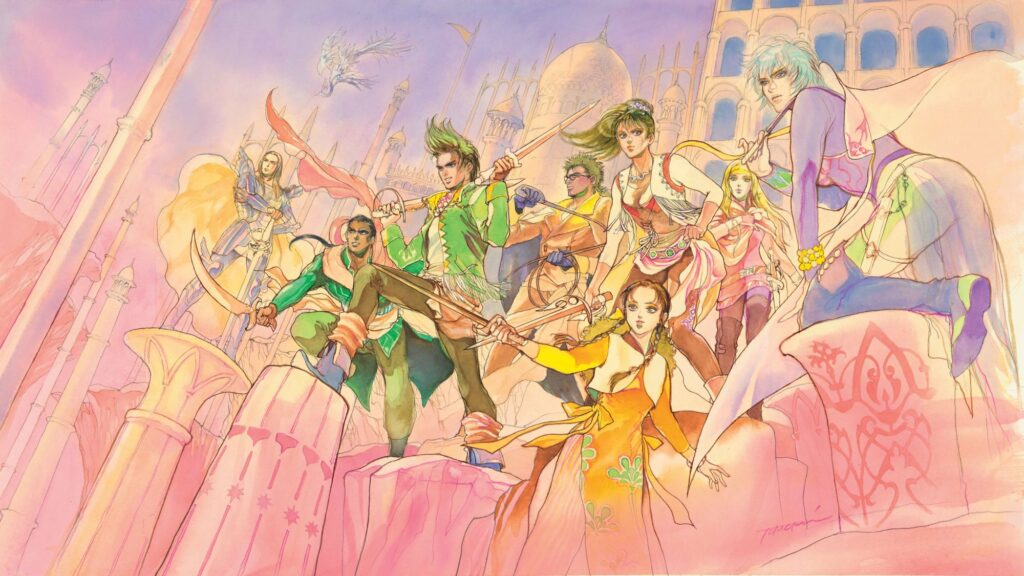“SaGa never dies. SaGa never ends. SaGa lives on.”
So proclaimed the E3 2019 trailer for Romancing SaGa 3‘s remaster and SaGa Scarlet Grace Ambitions, two titles that recently released as part of a revival of Square Enix’s RPG franchise. Akitoshi Kawazu, creator of the SaGa series, has established a forward momentum where further remasters of titles in the franchise, as well as a new entry, seem imminent. Kawazu, Masanori Ichikawa (Romancing SaGa re;UniverSe), and Hiroyuki Miura (SaGa Frontier Remastered) had time for a few quick questions about their projects.
While titles bearing the “SaGa” name are now in the double-digits, the plan wasn’t always to create a franchise in the vein of Final Fantasy or Dragon Quest. Kawazu adds: “We didn’t have the intention of creating an underlying identity for the series, either. The only goal for each title was to create an RPG that was different from any that came before it.”
Many RPGs, including others from Square Enix, follow particular conventions including a linear scenario where you proceed from point A to B, or battle mechanics that are clearly described. SaGa games are more interested in letting a player explore it’s world how players want, often by modular scenario design, often split between many protagonists that have a unique scenario. Why go this route instead of a singular protagonist and supporting cast?
“If you want to enjoy a story with one protagonist, a novel or movie would suffice. What’s great about RPGs is that there can be various perspectives within a single world.”
Trial by error is part of the idea in SaGa, and hits back at the idea that every nook and cranny of a game must be consumed to bestow a “full” experience. I wondered how, in the planning phase of these games, Kawazu’s team coalesce around this style of RPG. Much like those playing SaGa games, it’s a process of exploration:
“When we start production, we discuss what kind of title to create, and we start development work after getting a certain degree of consensus on what to focus on. That said, there have been many instances when we realized through multiple trials that our theories were incorrect.”
I was curious if there’s an aspect of video game RPGs that Kawazu himself would like to explore. With Unlimited SaGa on the PlayStation 2 feeling very much like a board game, it seems he has an affinity for incorporating those type of experiences in a video game format.
“I’d like to try creating an RPG that plays out from the perspective a game master, like with a tabletop RPG, although I still don’t have any ideas on how to execute it.”
Romancing SaGa Re;univerSe • First Hour Gameplay
Romancing SaGa Re;univerSe is the latest free-to-play service game for the series, and features characters from throughout the franchise. While set far in the future of Romancing SaGa 3, the game manages to work in the larger SaGa universe within. That’s all part of the plan according to producer Masanori Ichikawa. When new titles release, the plan is to add events themed around those games — so that Re;univerSe acts like a hub players can come back to.
When it comes to designing around retaining player interest in the service, Ichikawa considers designs that accommodate players to continue for free, such as “the distribution of free jewels, as well as how to provide surprises when information regarding the JP version is already available.” The Japanese version has a bit of lead time on the worldwide client, having released back in 2018, so it make sense that a global, internet-savvy audience can still enjoy events in spite of that gap.
SaGa Frontier Remastered released just a few short months ago, brining the PS1 gem to a new generation, replete with HD versions of pre-rendered backgrounds. It’s the first title in the series that is set outside of a traditional fantasy, and includes a charming collection of areas that have an idiosyncratic feel, due in part to the 8 protagonists you can play. If there’s a game from Square Enix’s catalogue that has a similar vibe, it’s Final Fantasy VII, which was also a first-step into a somewhat modern setting. I asked producer Hiroyuki Miura about that.
“I do believe there are similarities with Final Fantasy VII in that both titles use prerendering techniques for their backgrounds. As for the remastered version of SaGa Frontier, this time around we put emphasis on making the visuals look beautiful while still valuing their original look, as we didn’t want to betray fan expectations. If we’re going into details, when improving the resolution we would need to add in design details that we weren’t able to depict back then, so we were conscious of creating a design that wouldn’t veer off from the impression that fans of the original have. As for Fuse’s region ship, which was designed completely from scratch, we created model data to make it look like it existed in the original and depicted it using prerendered graphics.”
A lot of people who grew up playing RPGs in the time of pre-rendered backgrounds regard them with endearment, but I was curious if they have a relevant role in games developed in the future.
“Although prerendered backgrounds aren’t the most cutting-edge technology today, there are times when they’re partially used in some form, so I believe they will remain as a form of presentation. It may be interesting if titles were to fully adapt said form as a unique characteristic of the title, also.”

Recent Comments